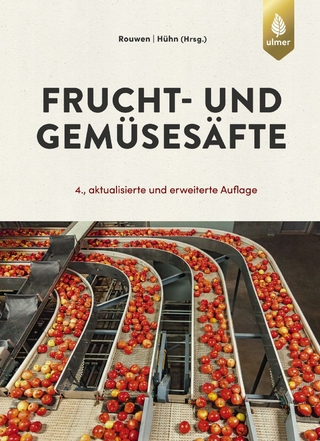
Nutri-Cereals
CRC Press (Verlag)
978-1-032-13584-7 (ISBN)
The term "Nutri-Cereals" has been dedicated to ten cereals due to their unique nutritional benefits. Nutri-Cereals: Nutraceutical and Techno-Functional Potential covers these cereal grains, with each chapter focusing on nutrient composition and bioactive characterization followed by associated bio-functional properties and health benefits. Further, it covers techno-functionality of nutri-cereals including rheological properties, emulsification and foaming potential, gelation behavior, color profile and others which dictate the suitability of cereals in finished products.
Key Features:
Covers diverse biological and functional features of nutri-cereals to dictate their potential as functional ingredients in value-added products
Discusses the nutraceutical potential of ten cereals: sorghum, pearl millet, finger millet, foxtail millet, barnyard millet, kodo millet, little millet, proso millet, black wheat and Amaranthus
Explains how these grains are ideal ingredients for gluten free food formulations with enhanced bio- and techno-functional characteristics
Although many of the nutri-cereals have been known for thousands of years, due to their coarse nature and lack of processing they escaped the human diet. Now, thanks to their excellent agro-economic potential and numerous health benefits, they are once again recognized as functional ingredients. Recently, earmarked investment and funding have been observed for valorization of these crops and thus, this book will help academicians to strengthen future investigations.
Rajan Sharma, PhD, is Teaching Assistant at Punjab Agricultural University, Ludhiana, India. Dr Sharma holds specialization in the domain of cereal technology. His doctoral dissertation focused on characterization, processing and value addition of Nutri-cereals. He obtained a B.Tech. (Hons) degree in Food Technology and M.E. Food Technology with merit from University Gold Medals. He has authored more than 25 peer-reviewed articles, 5 book chapters and 2 feature articles in reputed international and national journals. He is an active participant in international conferences, seminars and workshops. To his credit, he has won two prestigious awards – IFI Best Feature Article Award 2016, by the Association of Food Scientists and Technologists (India) and Outstanding Paper 2019 in Emerald Literati Awards Vikas Nanda, PhD, is Professor cum Head, Department of Food Engineering and Technology, Sant Longowal Institute of Engineering and Technology, Longowal, India. He is keenly involved in research and teaching activities over the last 20 years. His major areas of interest include the following: development of extrudates with nutraceutical properties; spray dried honey powder as a functional ingredient in value-added products; quantification of sugars from domestic honey variants; and extraction of bioactive compounds from food products using chromatographic techniques. He has attended and chaired several international conferences in India, Greece, France, Czech Republic, Argentina, Dubai and Netherlands. He is co-chairperson of International Honey Commission. He has supervised several graduate students and published more than 95 research papers and 30 book chapters in internationally known journals and books. He is also the recipient of several awards and distinctions dedicated to outstanding research work. Savita Sharma, PhD, is Principal Food Technologist (Dough Rheology) cum Head of the Department of Food Science and Technology at Punjab Agricultural University, Ludhiana, India. She has contributed more than 32 years of research, teaching and extension activities related to cereal science and technology. She has been working to develop novel technologies for cereal products such as functional foods and convenience products in addition to extensive characterization and utilization of bioprocessed grains, including cereals and pulses. She has supervised more than 30 MSc and 13 PhD scholars. She has completed 8 research projects funded by national agencies. She has authored 6 books and more than 150 peer-reviewed articles in renowned journals. She has attended and chaired several technical sessions in international conferences, conventions and seminars and is the recipient of several prestigious awards and distinctions, including Fellow of National Academy of Dairy Science (India).
1. Nutri-Cereals: Niche to Mainstream 2. Traditional vs. Modern Usage of Nutri-Cereals 3. Sorghum (Sorghum bicolor): Phytochemical Composition, Bio-Functional, and Technological Characteristics 4. Nutraceutical Potential and Techno-Functional Properties of Pearl Millet (Pennisetum glaucum) 5. Finger Millet (Eleusine coracana): Phytochemical Profile, Potential Health Benefits, and Techno-Functional Properties 6. Nutraceutical and Functional Attributes of Foxtail Millet (Setaria italica) 7. Proso Millet (Panicum miliaceum): Bioactive Composition, Pharmacological Impact and Techno-Functional Attributes 8. Kodo Millet (Paspalum scrobiculatum): Bioactive Profile, Health Benefits and Techno-Functionality 9. Bioactive and Techno-Functional Properties of Barnyard Millet (Echinochloa frumentacea) 10. Little Millet (Panicum sumatrense): Nutraceutical Potential and Techno-Functionality 11. Polyphenolic Composition, Nutraceutical Profile, and Techno-Functional Properties of Black Wheat 12. Phytochemical Composition, Nutraceutical, and Techno-Functional Attributes of Amaranth (Amaranthus cruentus) 13. Non-Food Novel Applications of Nutri-Cereals 14. Processing Technologies of Nutri-Cereals 15. Storage Stability and Quality Management of Nutri-Cereals and Associated Products 16. Economic, Social, and Market Feasibility of Nutri-Cereals
| Erscheinungsdatum | 16.08.2023 |
|---|---|
| Zusatzinfo | 27 Tables, black and white; 7 Line drawings, black and white; 3 Halftones, black and white; 10 Illustrations, black and white |
| Verlagsort | London |
| Sprache | englisch |
| Maße | 178 x 254 mm |
| Gewicht | 839 g |
| Themenwelt | Technik ► Lebensmitteltechnologie |
| Weitere Fachgebiete ► Land- / Forstwirtschaft / Fischerei | |
| ISBN-10 | 1-032-13584-0 / 1032135840 |
| ISBN-13 | 978-1-032-13584-7 / 9781032135847 |
| Zustand | Neuware |
| Informationen gemäß Produktsicherheitsverordnung (GPSR) | |
| Haben Sie eine Frage zum Produkt? |
aus dem Bereich


